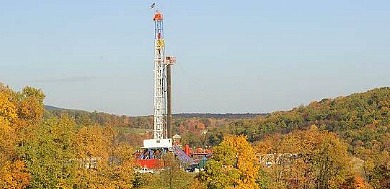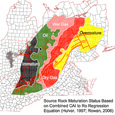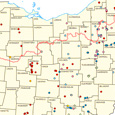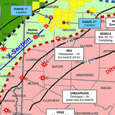Can Ohio avoid the natural gas ‘boom’ and ‘bust’ cycle?
Saturday, June 9, 2012

Facts:
-
In their new policy brief, Ohio State University authors Michael Farren, Amanda Weinstein and Mark Partridge illustrate how Ohio could reduce the risk of a boom/bust cycle by examining how Calgary in Alberta, Canada, has dealt with an oil boom that started in the late 1940s.
After oil prices reached a peak in 1981, Calgary began a concerted effort to diversify its economy by offering tax credits and access to capital to small businesses and new industries.
Alternatively, the authors examine the example of Williston, N.D. The area experienced a significant oil boom in the 1970s and a subsequent bust in the early 1980s.
“Then, for a period of over 20 years, there was virtually no economic growth,” Farren said.
In recent years, the area has found itself experiencing another oil boom, resulting in low unemployment and high growth, but also in overcrowded schools, a spike in crime, higher housing costs and strain on roads, bridges, the sewer system, the water system and the energy grid.
“Just as you wouldn’t want a government policy overly distorting the economy, you don’t want an economic boom to distort the economy in a way that is going to lead to long-term economic problems,” Farren said.
Get the details
The policy brief was funded completely by the C. William Swank Program in Rural-Urban Policy, housed in Ohio State’s Department of Agricultural, Environmental and Development Economics.
The full policy brief, along with the program’s previous analyses, are available online: http://go.osu.edu/swank.
COLUMBUS — Ohio needs to take steps to make sure the state benefits from the shale energy boom in both the short- and long-term.
Without action, regions of the Buckeye State could enter a boom/bust cycle that would likely have long-lasting negative effects, according to Ohio State University analysts.
“Future growth might stagnate because the natural capital and public capital, like infrastructure and amenities, will be degraded by the boom — by the rush to economic windfall,” said Michael Farren, a doctoral student in Ohio State University’s C. William Swank Program in Rural-Urban Policy.
“But there are ways to prevent the boom from actually causing a worse bust in the future.”
Farren recently co-authored a policy brief, Making Shale Development Work for Ohio, with doctoral candidate Amanda Weinstein, and Mark Partridge, ag economist and chair of the program.
(Scroll down to see Michael Farren discussing the new policy report.)
Don’t delay
The authors recommend the state soon take action to:
– Apply an appropriate level of severance taxes on companies that extract shale gas, oil and other resources; and
– Use the funds collected to pay for both the immediate costs of the industrial activity, including the upgrade and maintenance of roads, bridges, water supplies and other public amenities, as well as for long-term costs, particularly to help boost education and economic diversification.
Will history repeat?
Ohio can learn from other regions’ mistakes as well as their good practices, Farren said, to avoid the “natural resource curse.”
“It’s counterintuitive that having higher resources would lead to lower long-term growth, but it happens so often that it has become its own area of academic study,” Farren said.
The authors describe a “Vicious Cycle of the Resource Bust,” illustrated in the Appalachian coal boom of the 1970s, like this:
A boom in one sector of the economy, such as coal mining or shale gas and oil extraction, leads to a strong, often sudden, growth in low-skill, high-paying jobs in that sector. The availability of such jobs leads young workers away from advanced education or other high-skill training opportunities.
Other industries avoid the region because of both the reduced job skills in the workforce and the higher wages in the area.
As the availability of the natural resource wanes due to extraction — or when its value decreases due to other economic forces — employment in the sector drops precipitously.
With no other viable options, the economic decline causes workers to migrate out of the area in search of other opportunities.
Headed down same path
Weinstein said it’s common to hear “this time it’s different” regarding the shale energy boom in Ohio.
“But we’re here to say that it’s not going to be different” — unless Ohio enacts new policies to ensure a different outcome.
Currently, Ohio’s severance taxes on the oil and gas industry are among the lowest in the nation, amounting to 3 cents per thousand cubic feet of natural gas and 20 cents per barrel of oil.
The funds are used to pay for costs borne by the Ohio Department of Natural Resources to regulate the industry.
“That in itself is not a bad thing,” Farren said. “You want to make sure the regulatory costs of the industry are compensated. But over the course of the boom, there are going to be a lot more economic effects than just the cost of regulation.
“We think it’s important that Ohio not give a handout to out-of-state energy companies, and that it sets its severance taxes so that the total cost of extraction of the resource from Ohio is compensated for.”
Partridge added: “You want to make sure all the relevant costs are paid for by the industries that are benefiting from the resource, so the costs aren’t pushed onto others. The economics literature suggests that you should improve infrastructure and education, and then find a way to share revenues with the affected communities.”
And Weinstein said policy-makers should strive for balance: “For example, the boom might increase the benefit of not pursuing higher education, but you could counteract that effect by decreasing the costs of going to school.”
Leaders off track
The analysts say recent proposals to increase taxes on the oil and gas industry in Ohio — both by Gov. John Kasich and by Democrats in the Ohio legislature — lack key ingredients that would help Ohio avoid the natural resource curse.
The governor’s proposal would use the extra taxes to reduce the state’s income tax, which, the authors say, “may not be the most effective method to avoid the adverse effects of the resource curse.”
The Democrats’ proposal would use extra funds to generate increased employment in schools and public service positions, but — while a step in the right direction — wouldn’t be as effective as directing funds toward specific degree programs that would contribute toward economic growth and diversity.
“We have this wealth that is literally a part of the land,” Farren said. “That natural wealth is leaving, and, because we can never get it back, we want to make sure we do something to retain some of the value lost.”




